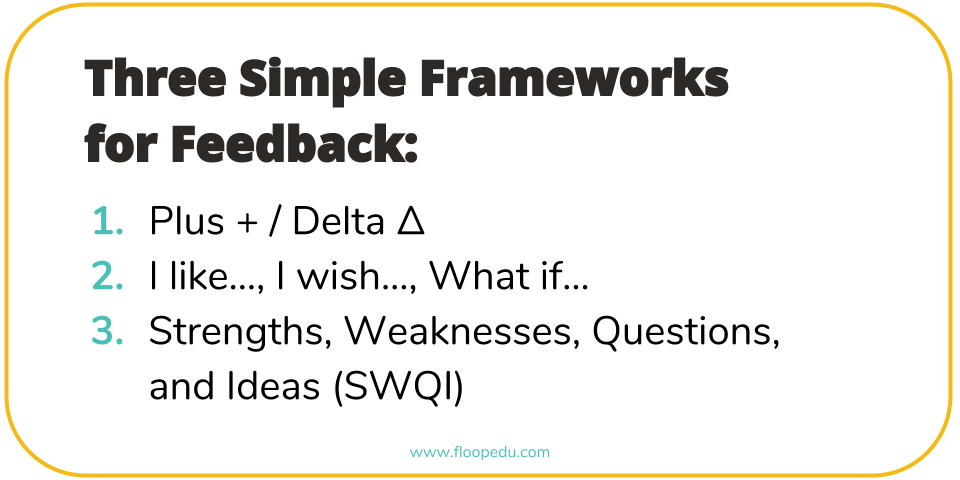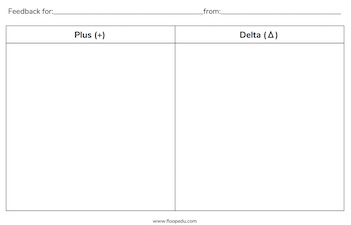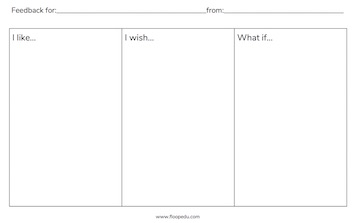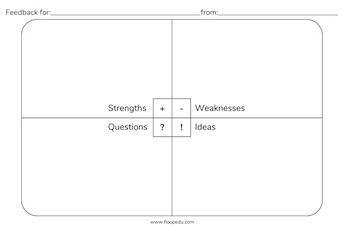Here at Floop, we’re all about creating effective feedback systems that mix different strategies to best meet your students’ needs. This post is part of a series sharing simple feedback strategies.
When giving or receiving feedback, using a structured framework helps keep the feedback constructive and balanced. Here are three of my favorite feedback methods, all of which are general enough to be used for any situation.



Strengths, Weaknesses, Questions, Ideas (SWQI)
Organize your feedback into these four quadrants: Strengths, Weaknesses, Questions, and Ideas. In this comprehensive method, there is a place for any kind of feedback you have, and seeing the feedback written on paper encourages you to provide a wide range of feedback.

I confess that when I printed these out for my classroom, I changed the word “weaknesses” to “what could be improved.” Are you cautious about using the word “weakness”? How do you perceive this word, and how do your students perceive it?
Keep us in the Floop!
When giving or receiving feedback, using a structured framework helps keep the feedback constructive and balanced. Here are three of my favorite feedback methods, all of which are general enough to be used for any situation.

Plus (+) / Delta (Δ)
Pluses are positive things to keep or repeat, while deltas (the Greek character often used to represent change) are changes to make in the future. To use the plus/delta framework, create a T-chart to log pluses and deltas. Here’s the key: deltas must be action-oriented, meaning they are positively framed actions versus negative complaints. A simple example is when giving feedback on student presentations, say “please speak louder” instead of “you’re mumbling.”
I like…, I wish…, What if…
To use this feedback method, list praise with “I like…,” criticism with “I wish…,” and then suggestions with “What if…” For the same example of student presentations, you could say “I like how fluid your presentation felt. I wish I could hear you better! What if you practiced projecting your voice to the back of the room?” (Note: Likes don’t need to match wishes, but wishes should match what-ifs.) Starting your likes and wishes with the word “I…” helps frame your feedback as personal observations and opinions, which in turn makes the feedback easier to accept by the feedback recipient. Then, having the “what if” column encourages you to think constructively about how to turn critique into a suggestion.
Strengths, Weaknesses, Questions, Ideas (SWQI)
Organize your feedback into these four quadrants: Strengths, Weaknesses, Questions, and Ideas. In this comprehensive method, there is a place for any kind of feedback you have, and seeing the feedback written on paper encourages you to provide a wide range of feedback.

I confess that when I printed these out for my classroom, I changed the word “weaknesses” to “what could be improved.” Are you cautious about using the word “weakness”? How do you perceive this word, and how do your students perceive it?
How I use these frameworks
The power of these frameworks is in their flexibility for feedback on any assignment, activity, or situation. In addition, they can be used in a multitude of ways, from structuring a group discussion or organizing written feedback. Here are just a few ways I use these methods in my classroom:- When students assess each other’s notebooks, they leave a sticky note with a plus/delta T-chart.
- After students present in small groups, other students give feedback verbally using “I like..., I wish…, What if…” as sentence starters.
- When visitors come to my classroom to watch student presentations, I have a stack of SWQI forms printed and ready to go.
- After completing a design challenge, students complete an individual plus/delta reflection in their own notebooks.
- For teacher feedback, when I complete a unit, I facilitate a class conversation around plus/delta and fill out the T-chart on the board.
Keep us in the Floop!
Comments
Post a Comment